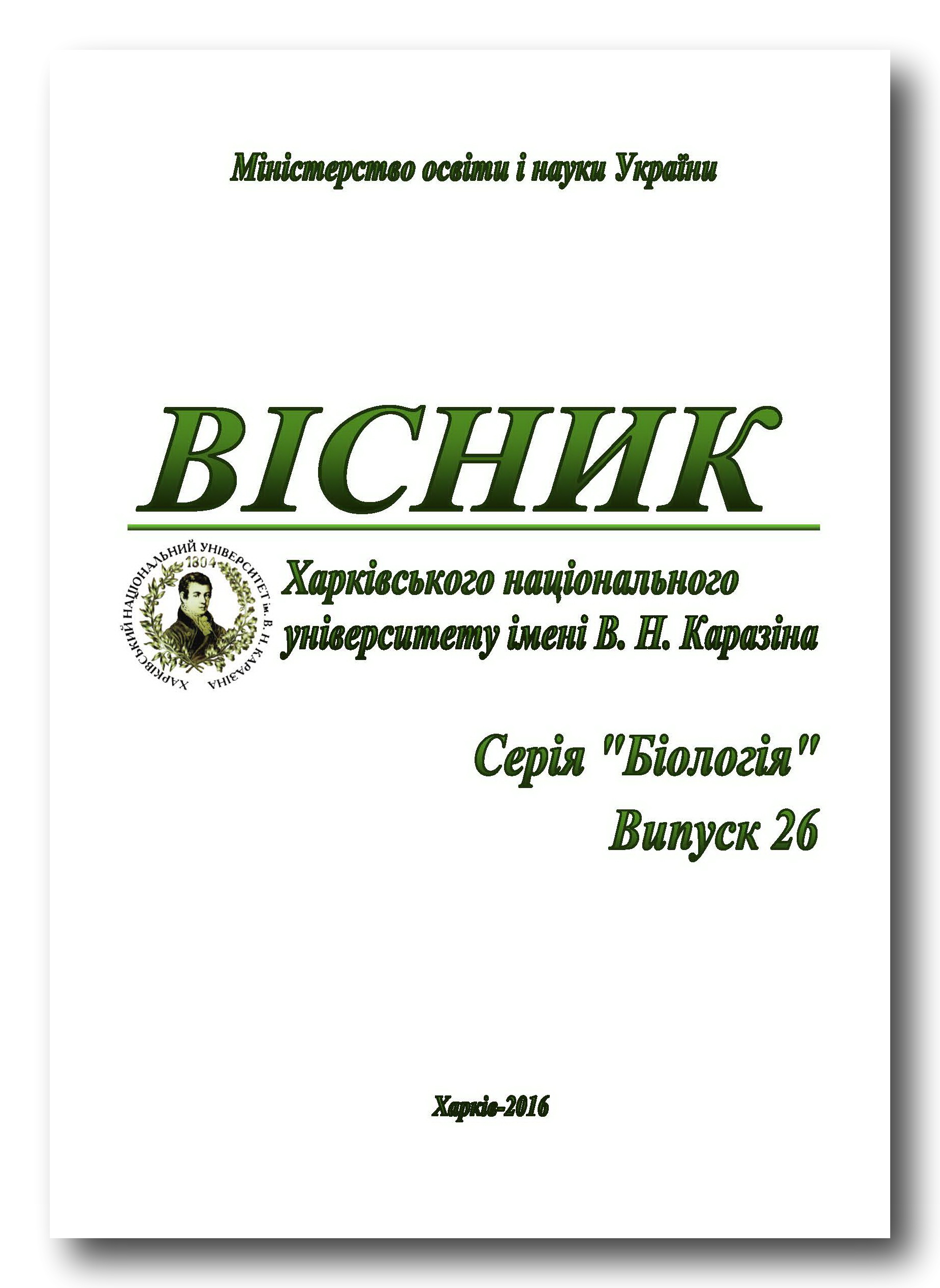The lack of correlation between the level of radioactive contamination and infection with Wolbachia in natural populations of Drosophila melanogaster from Ukraine
Abstract
We analyzed Wolbachia infection rates in natural populations of Drosophila melanogaster from conditionally clean and contaminated localities in Ukraine. This parameter was lower in the most heavily contaminated locality (Janiv, 13.5 mSv/h) – 29.4% compared with the other 6 studied natural populations of Ukraine (from localities Poliske, Chernobyl NPP cooling pond, Chernobyl, Kyiv, Varva, Uman). We observed no correlation between Wolbachia infection rate and radiation background in the localities, where was collected samples in August-September 2014.
Downloads
References
Brennan L.J., Haukedal J.A., Earle J.C., Keddie B., Harris H.L. Disruption of redox homeostasis leads to oxidative DNA damage in spermatocytes of Wolbachia-infected Drosophila simulans // Insect Molecular Biology. – 2012. – Vol.21 (5). – P. 510–520. – doi: 10.1111/j.1365-2583.2012.01155.x.
Duron O., Bouchon D., Boutin S. et al. The diversity of reproductive parasites among arthropods: Wolbachia do not walk alone // BMC Biology. – 2008. – Vol.27 (6). – P. 1–12. – doi: 10.1186/1741-7007-6-27.
Kohler R.E. Lords of the fly: Drosophila genetics and the experimental life. – Chicago: University of Chicago Press, 1994. – 344p.
Möller A.P., Mousseau T.A. Are organisms adapting to ionizing radiation at Chernobyl? // Trends Ecol. Evol. – 2016. – doi: 10.1016/j.tree.2016.01.005.
Mousseau T.A., Möller A.P. Genetic and ecological studies of animals in Chernobyl and Fukushima // Journal of Heredity. – 2014. – Vol.105 (5). – P. 704–709. – doi: 10.1093/jhered/esu040.
O’Neill S.L., Giordano R., Colbert A.M. et al. 16S rRNA phylogenetic analysis of the bacterial endosymbionts associated with cytoplasmic incompatibility in insects // Proc. Natl Acad. Sci. USA. – 1992. – Vol.89 (7). – P. 2699–2702.
O'Neill S.L., Hoffmann A.A., Werren J.H. Influential passengers: inherited microorganisms and arthropod reproduction. – Oxford University Press, Oxford – 1997. – 214p.
Riegler M., Sidhu M., Miller W.J., O'Neill S.L. Evidence for a global Wolbachia replacement in Drosophila melanogaster // Curr. Biol. – 2005. – Vol.15 (15). – P. 1428–1433. – doi: 10.1016/j.cub.2005.06.069.
R Core Team (2015). R: A language and environment for statistical computing. R Foundation for Statistical Computing, Vienna, Austria. (https://www.R-project.org/)
Serga S., Maistrenko O., Rozhok A. et al. Fecundity as one of possible factors contributing to the dominance of the wMel genotype of Wolbachia in natural populations of Drosophila melanogaster // Symbiosis. – 2014. – Vol.63 (1). – P. 11–17. – doi: 10.1007/s13199-014-0283-1.
Spearman C. The proof and measurement of association between twothings // Am. J. Psychol. – 1904. – Vol.15 (1). – P.72–101.
Starr D.J., Cline T.W. A host parasite interaction rescues Drosophila oogenesis defects // Nature. – 2002. – Vol.418 (6893). – P. 76–79. – doi: 10.1038/nature00843.
Stouthamer R., Breeuwer J.AJ., Hurst G.D.D. Wolbachia pipientis: microbial manipulator of arthropod reproduction // Ann. Rev. Microb. – 1999. – Vol.53. – P. 71–102. – doi: 10.1146/annurev.micro.53.1.7.
Sun S., Cline T.W. Effects of Wolbachia infection and ovarian tumor mutations on Sex-lethal germline functioning in Drosophila // Genetics. – 2009. – Vol.181 (4). – P. 1291–1301.
– doi: 10.1534/genetics.108.099374.
Wang L., Zhou C., He Z. et al. Wolbachia infection decreased the resistance of Drosophila to lead // PLoS ONE. – 2012. – Vol.7 (3). – P. 1–7. – doi: 10.1371/journal.pone.0032643.
Weinert L.A., Araujo-Jnr E.V., Ahmed M.Z., Welch J.J. The incidence of bacterial endosymbionts in terrestrial arthropods // Proc. R. Soc. B Biol. Sci. – 2015. – Vol.282. – P. 3–8. – doi: 10.1098/rspb.2015.0249.
Werren J.H., Baldo L., Clark M.E. Wolbachia: master manipulators of invertebrate biology // Nature Reviews Microbiol. – 2008. – Vol.6 (10). – P. 741-751. – doi: 10.1038/nrmicro1969.
Zilber-Rosenberg I., Rosenberg E. Role of microorganisms in the evolution of animals and plants: the hologenome theory of evolution // FEMS Microbiology Reviews. – 2008. – Vol.32 (5). – P. 723–735. – doi: 10.1111/j.1574-6976.
Authors retain copyright of their work and grant the journal the right of its first publication under the terms of the Creative Commons Attribution License 4.0 International (CC BY 4.0), that allows others to share the work with an acknowledgement of the work's authorship.




